Mr Thompsons Railway

Southend-on-Sea
The
site
of
the
popular
extension
of
Peter
Pans/Adventure
Island
was
originally
just
part
for
the
foreshore,
twice
a
day
the
tide
would
wash
over
the
area
at
high
tide
and
recede
to
reveal
nothing
but
sand
and
mud
at
low
tide.
To
extend
the
width
of
the
seafront
the
local
council
undertook
a
major
land
reclamation
project
in
1931
creating
a
dammed
area
and
draining
the
water
inside,
this
was
then
partly
refilled
with
soil
and
landscaped.
The
project
created
two
new
attractions,
one
the
western
side
of
the
pier,
the
reclaimed
land
was
sculptured
to
create
the
“Sunken
Gardens,”
these
being
below
the
level
of
the
promenade.
On
the
eastern
side
of
the
pier
a
Marine
Lake
was
opened,
the
water
entered
through
sluice
gates
as
the
tide
came
in
and
a
non
return
valve
would
swing
over
to
close
off
the
gate
to
stop
the
water
escaping
at
low
tide,
when
the
tide
returned
a
pump
would
start
forcing
the
water
currently
held
in
the
lake
out
whilst
the
sluice
gates
would
permit
fresh
sea
water
in.
The
new
attractions
proved
popular
with
residences
and
visitors
alike,
the
lake
was
used
as
a
boating
lake
with
rowing
boats
available
for
hire.
The
two
sites
carried
on
in
this
format
for
many
years,
however, the western side was soon to be developed much quicker than the Eastern side.
The
Western
side
gained
a
number
of
children’s
attractions
in
1950
including
slides,
swings
and
roundabouts,
and
by
1952
a
go-cart
track
had
been
built.
The
site
became
known
as
Peter
Pans
Playground
by
1956,
rapidly
losing
its
gardens
and
becoming
a
theme
park.
The
Eastern
side
developed
in
a
much
more
sedate
way,
by
1956
the
row-boats
had
been
joined
by
small
motor
boats
and
in
the
north-western
corner
a
group
of
trampolines
had
been
erected,
on
the
site
immediately
above
and
to
the
east
of
the
sunken
lake
on
a
concrete
terrace
an
open
air
children’s
theatre
was
erected.
The
Marine
Lake
was
a
popular
place
for
people
to
sit
and
relax
from
the
hustle and bustle of the seafront.
The
first
major
development
of
the
lake
site
since
it
was
first
built
was
the
construction
of
a
miniature
railway,
the
railway
was
to
be
built
in
a
10¼
inch
scale.
The
project
almost
failed
as
during
construction
the
developer
went
bust,
the
site
was
bought
by
Mr
Thompson
who
continued
with
the
building
of
the
miniature
railway,
the
railway
took
its
name
from
the
new
owner.
The
400
yard
line
ran
round
the
lake
in
an
oval
shape.
The
track
was
made
from
white
aluminium
laid
over
hardwood
sleepers
which
were
set
in
a
shallow
layer
of
concrete
as
it
crossed
the
three
paved
sides
of
the
lake
whist
on
the
forth
side
nearest
the
promenade
the
track
was
laid
on
the
stone
ballast
that
made
up
the
landing
stage
of
the
boating
lake
boarding
stage.
The
only
platform
on
the
railway
was
found
on
the
promenade
side
(northern
side)
the
platform
sat
about
10
foot
higher
than
the
rest
of
the
railway
the
gradient
leading
into
and
out
of
the
platforms
were
quite
steep
which
the
small
engine
would
barely
creep
up.
There
were
no
fences
around
the
track
or lake with only a small fence round the platform and boat boarding area.
The
railway
opened
in
July
1977
with
a
single
engine,
the
0-4-0
freelance
was
built
in
house
using
a
Cromar
coach
bogie.
Power
came
from
a
battery
motor
salvaged
from
a
bumper
car
chain
linked
to
one
axle.
Two
cross
over
points
were
installed
on
ran
to
a
corrugated
iron
shed
used
as
a
workshop
alongside
the
boating
lake,
the
second
attached
to
a
siding
that
ran
to
a
old
deckchair
store
under
a
concrete
terrace
at
the
Eastern
end
of
the
lake.
The
engine
was
drastically
under
powered
and
would
normally
only
haul
a
single
white
clouded
open
carriage,
a
second
carriage
was
available
for
busy
times
but
the
small
engine
would
struggle
to
pull both with passengers.
The
original
developer
had
ordered
a
model
Gresley
V2
steam
locomotive
from
Viking
Locomotives
of
Sheringham,
however,
after
evaluating
the
layout
of
the
track
and
the
design
of
the
steam
engine
it
was
found
that
the
V2
model
would
struggle
to
cope with the sharp curves so during construction the design was altered to 2-4-2 standard.
Viking
Locomotives
was
a
small
one
man
operation
and
work
on
the
Southend
engine
progressed
slowly
and
deadlines
slipped,
it
was
only
after
the
threat
of
legal
action
that
the
engine
arrived
in
Southend.
Despite
the
arrival
of
the
engine
it
was
still
not
in
a
fit
state
to
operate
on
the
railway,
work
to
bring
the
traction
gear
up
to
a
safe
standard
was
needed
as
was
the
installation
of
a
brake
was
also
needed.
The
new
engine
had
been
built
to
a
15inch
scale
despite
the
railway
being
in
10¼
inch
scale,
it
weighed
in
at
two
tons,
this
proved
to
be
very
wearing
on
the
soft
white
aluminium
tracks
with
the
majority
of
wear
occurring
on
the
outer
rails
on
the
curves
and
at
crossing
points.
The
new
steam
engine
first
steamed
in
August
1977
it
had
been
named
after
its
builder
“Viking,”
it
proved
to
be
a
very
powerful
engine
more
than
capable
of
pulling
five
open
Cromar
carriages
full
of
passengers.
The
new
engine
was
pressed
into
service
and
proved
a
popular
edition
to
the
railway,
however,
design
and
construction
issues
arose
with
the
engine,
these
included
poor valve timing, lack of lubrication nipples and small bearings.
At
the
close
of
the
1977
season
the
engine
was
hauled
into
the
workshop
where
a
major
refurbishment
of
its
traction
and
motion
gearing, the number of grease points was increased to the slide bars and the drive wheels were re-engineered.
Before
the
1978
season
could
start
adversely
high
tides
in
the
March
flooded
the
site
to
a
height
of
10ft,
the
engine
shed
and
carriage
store
were
both
flooded
out
and
the
boats
in
the
lake
sunk,
the
platform
disappeared
under
the
water.
The
water
took
over
a
week
to
drain
out
and
repairs
to
the
track
took
a
month.
The
Viking
had
been
partly
submerged
for
a
week
after
an
overhaul
in
which
the
gears were all stripped off and cleaned, and the boiler and pipe work were flushed the train was steaming again by the start of April.
The
railway
added
a
second
engine
in
August
1978
this
was
a
diesel
based
on
a
class
31,
the
engine
was
built
around
the
original
battery powered 0-4-0 freelance engine, only the bogie was used in the construction of the new engine.

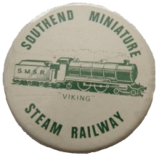
The
new
engine
was
twin
chain
driven
with
power
coming
from
a
Ford
1300
engine
taken
from
a
Ford
Escort,
the
original
gearbox
was
retained
to
give
four
forward
gears
and
one
reverse,
the
engine
was
originally
presented
in
a
red
and
white
scheme,
later
re-
painted in British Rail blue.
The
diesel
would
start
the
working
day
on
the
railway
whilst
Viking
was
made
ready
and
steamed
up,
the
diesel
would
then
be
kept
on
the
siding
whilst
Viking
ran
the
service,
when
Viking
had
to
top
up
its
water
tank
the
diesel
would
resume
the
service.
The
railway
had
a
rolling
stock
of
the
two
engines
and
six
carriages,
only
five
carriages
could
only
be
used
as
the
sixth
had
donated
its
bogies
to
the
original
0-4-0
freelance
engine
and
then
to
the
Class31
the
body
of
the
disused
carriage
was
kept
in
storage
inside
the
carriage
shed under the concrete terrace.
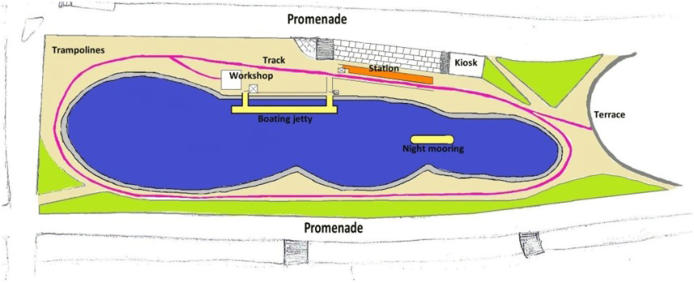
The
railway
with
the
Viking
was
sold
by
Mr
Thompson
in
1981,
the
line
was
solely
operated
by
the
Class31
diesel
until
the
railway
closed
in
1986.
The
closure
was
put
down
to
the
rising
costs
operating
the
line,
the
fall
in
passenger
numbers
and
the
need
to
replace
the
track
and
the
engine.
Despite
the
closure
of
the
railway
the
boating
lake
remained
open
as
did
Jumpin
Jimmy’s
Trampolines.
However,
after
a
few
years
the
trampolines
and
boating
lake
were
closed
and
the
site
fell
into
dereliction.
The
site
remained
derelict
for
almost
a
decade
until
Philip
Miller
the
owner
of
Peter
Pans
Playground
took
over
the
site
and
begun
a
major
expansion
of
the
Theme
Park,
today
the
site
is
brimming
with
white
knuckle
rides
as
well
as
more
sedate
rides
for
toddlers,
a
restaurant
is
now
housed
in
the
former
carriage
store
under
the
balustrade
whilst
on
top
of
the
restaurant
is
a
mini
golf
course.
One
of
the
rides
carries
on
the
tradition
of
a
miniature
railway
on
the
site,
the
Jungle
Express
is
a
small
oval
shaped
railway
running
under
its
much
bigger
faster
counterpart the Green Scream.
Many thanks to Mr Bruce Knights of Knights Rail Services for his kind permission to use the photos of the railway below.
Mr
Knights
informed
the
Timeline
that
the
carriage
store
under
the
terrace
was
actually
too
short
to
store
all
the
carriages
in
a
line,
so
a
section
of
track
was
left
unbolted
so
that
it
could
be
swung
to
be
connected
to
a
second
section
of
track
laid
alongside
the
main
siding so that the carriages would sit alongside each other inside the store.
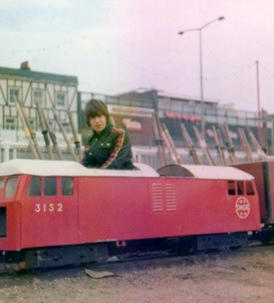
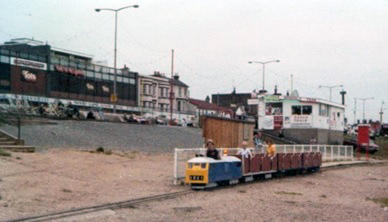
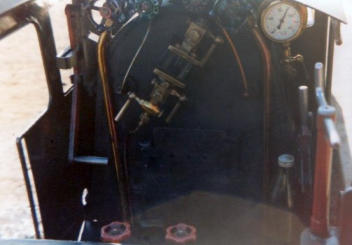
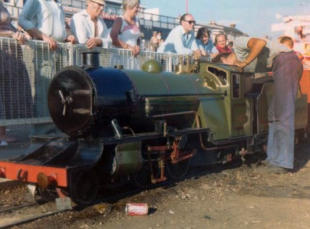
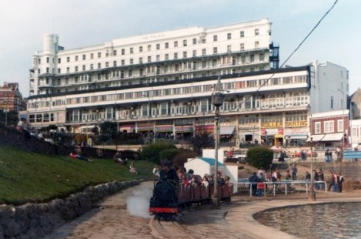
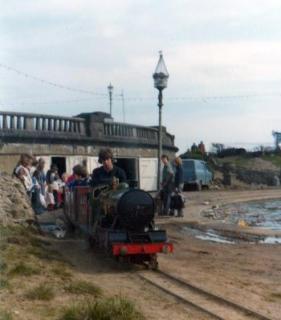
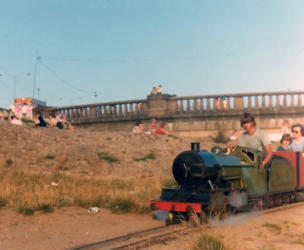
Mr
Knights
at
the
controls
of
the
diesel
loco
at the end of its first season
The
diesel
loco
just
out
of
the
paint
shop,
the
red
structure
in
the background is the water tower for the Viking
The
Viking
climbing
the
incline
to
the
station. Photo taken soon after the floods
Mr
Knights
preparing
the
Viking
for
a
trip
around
the lake
The
Viking,
the
Boating
Lake,
Jumpin
Jimmys
and
the
Palace Hotel
The
driver’s
compartment
of
the
Viking,
steam
valves
for
the
injectors,
the
green
blower
valve
and
the
red
brake
valve
that
was
never
connected.
The
water
gauge
is
in
the
middle
and
the
pressure
is
showing
100psi.
Regulator is on the left and reverser on the right
The
Viking
starting
up
the
incline.
The
escaping
steam
shows
that
the
drain
cocks
are
open
for
effect
and
there
is
a
blow
from
the
cylinder
gland, so its probably late in the season
Southend Timeline Southend-on-Sea © 2009 - 2024. All Rights Reserved



Southend-on-Sea’s No 1 History Website! Documenting The Town & The Townspeople

Now Incorporating The Sea Of Change Website
Website Info:


Chalkwell ▪ Eastwood ▪ Leigh-on-Sea ▪ Prittlewell ▪ Shoeburyness ▪ Southchurch ▪ Thorpe Bay ▪ Westcliff-on-Sea
SOUTHEND CITY
































































